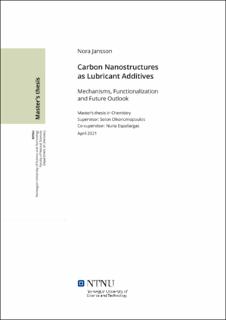| dc.description.abstract | Friksjon og slitasje mellom overflater i kontakt og relativ bevegelse er viktige kilder til energitap som kan reduseres gjennom bruk av smøremidler. Moderne, flytende smøremidler er komplekse kjemiske systemer som består av en hovedvæske, som gir smøremiddelet sine grunnegenskaper, samt en rekke funksjonelle tilsatsstoffer som tilpasser smøremiddelets egenskaper til spesifikke bruksområder. Økt miljøhensyn og strengere regulering av utslipp i senere år har forsterket behovet for nye tilsatsstoffer med redusert miljøpåvirkning.
På bakgrunn av attraktive mekaniske, termiske og kjemiske egenskaper har karbon nanostrukturer blitt foreslått som aktuelle kandidater til denne nye generasjonen av friksjon- og slitasjereduserende tilsatsstoffer. Men, til tross for mye forskning på karbon nanostrukturer de siste 20 årene har en helhetlig forståelse av mekanismene som står bak deres smørende egenskaper uteblitt. Og, selv om funksjonalisering av overflaten som regel er nødvending for å kunne dispergere disse nanostrukturene i smøremidler, er det få studier som har undersøkt hvordan overflatefunksjonalisering påvirker ytelsen til smøremiddelet utover dispersjonsstabilitet.
Målet for denne masteroppgaven er å oppsummere og systematisere tilgjengelig litteratur på smøreegenskapene til karbon nanostrukturer, og bidra til framtidig etablering av retningslinjer for videre forskning på temaet. Dette ble gjort ved å identifisere og kategorisere de aktuelle nanostrukturene, kritisk evaluere de foreslåtte smøremekanismene og undersøke effekten av overflatefunksjonalisering under smøring.
Det ble funnet at karbon nanostrukturer kan ha svært varierende mekaniske og kjemiske egenskaper, samt ulik morfologi, og at dette påvirker hvordan de kan bidra til friksjon- og slitasjereduksjon under smøring. Dimensjonalitet, strukturell integritet og tilbøyelighet for kjemiske interaksjoner ble identifisert som spesielt innflytelsesrike parametere som påvirker smøreevne. Vurdering av det teoretiske grunnlaget for de foreslåtte smøremekanismene i litteraturen avslørte at vår forståelse av de underliggende fenomenene er begrenset. Til tross for disse konseptuelle tvetydighetene, ble det konkludert med at enkelte av karbon nanostrukturene (spesfikt carbon quantum dots og grafén-baserte strukturer) allikevel er lovende kandidater for fremtidige tilsatsstoffer fordi de er gode bærematerialer. Disse bæreegenskapene, kombinert med innholdsrik og veletablert karbonkjemi, tilrettelegger for funksjonalisering av karbon-baserte tilsatsstoffer med skreddersydde egenskaper. Muligheten for slik tilpasning åpner døren for utvikling av tilsatsstoffer med spesifikke smøremekanismer og muligens multifunksjonalitet. | |
| dc.description.abstract | Friction and wear between contacting surfaces in relative motion are major sources of energy loss that can be mitigated through various lubrication strategies. Today, most liquid lubricants are complex chemical systems comprised of a base fluid, which provides the main performance properties, and several carefully selected functional additives, which provide the base fluid with the necessary functionalities for each targeted application. In recent years, increased environmental concern and regulations have fueled the search for new base fluids and lubricant additives with reduced environmental impact.
Owing to their attractive mechanical, thermal, and chemical properties, carbon nanostructures have been proposed as potential candidates for a new generation of friction-modifying and antiwear additives. However, despite much research on the lubrication performance of carbon nanostructures over the last couple of decades, a comprehensive understanding of the mechanisms by which carbon nanostructures reduce friction and wear is still lacking. Furthermore, surface functionalization is generally required to achieve stable dispersion of carbon nanostructures in the lubricant. Yet, few studies have attempted to discern how functionalization influences the lubrication performance of the nanoadditives beyond improving dispersibility.
This thesis aims to review and systematize the growing body of literature on the performance of carbon nanostructures as lubricant additives and contribute to the establishment of better guidelines for future research and development on the subject. This was achieved by identifying and categorizing the carbon nanostructures in question, critically evaluating their proposed lubrication mechanisms, and investigating the role of surface functionalization in lubrication.
It was found that carbon nanomaterials can exhibit a wide range of structural, mechanical, and chemical properties, and that this greatly influences the mechanisms by which they can reduce friction and wear when employed as additives. More specifically, dimensionality, structural integrity, and the nature of chemical interactions were identified as particularly important parameters governing the tribological behavior of carbon nanostructures. Evaluation of the theoretical basis for the proposed lubrication mechanisms revealed that several of the mechanisms are still quite poorly understood. However, despite certain ambiguities at the conceptual level, it was concluded that certain carbon nanostructures (carbon quantum dots and graphene-based nanostructures) are promising candidates for a new generation of lubricant additives due to their excellent properties as carrier materials and the well-established and rich chemistry of carbon. Together, these properties offer several routes for surface functionalization and endless opportunities for tailoring additive properties. As a result, surface functionalization has the potential to not only affect dispersibility but also enhance the inherent lubrication mechanisms of the nanostructure and potentially allow for development of multifunctional additives. | |
